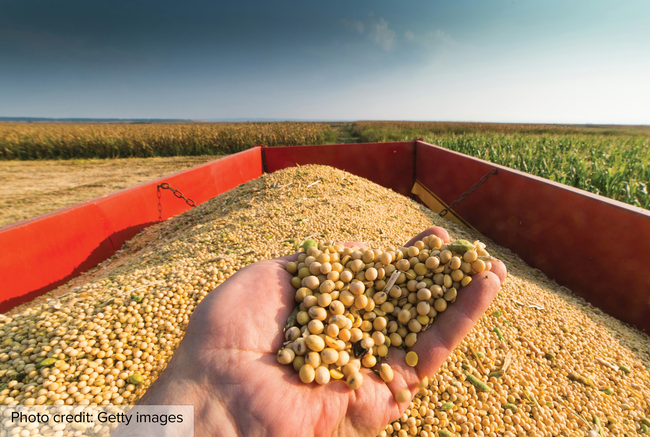Posts Tagged: development
The unintended consequences of clean fuel policies
How policies affect emissions, land use, and the prices of fuel and vegetable oils
Over the last two decades, both the federal government and state governments have enacted policies to reduce greenhouse gas (GHG) emissions in the transportation sector. In a new Special Issue of ARE Update, University of California agricultural economists explore how these federal and state renewable fuel policies have affected biofuel production for motor and aviation fuels and consider how these policies have affected land use and food prices. Their research shows that as U.S. demand for renewable diesel began to outpace supply, consumer prices for vegetable oil—which is used as a feedstock for renewable diesel—surged.
The national Renewable Fuel Standard (RFS) and California's Low Carbon Fuel Standard (LCFS), implemented in 2006 and 2011, respectively, have led to an increase in the amount of biofuels consumed and produced in the United States. While the RFS mandates that a minimum volume of renewable fuels be blended into U.S. transportation fuels, the LCFS sets an annually increasing targeted reduction in transportation-related carbon emissions. The LCFS set a 2030 target date to reduce GHG emissions by 20% through the development of a carbon trading program that requires refiners who produce ‘dirtier' fuels to buy credits from those who produce cleaner (e.g., renewable) fuels.
The authors show that after 2020, whenLCFS credit prices (i.e.,biofuel subsidies) were high, California saw an increasing volume of motor fuel coming from renewable diesel — which previously only made up around 5% of the state's diesel blend. Currently, the retail diesel blend in California is 35% conventional diesel and 65% renewable diesel.
By 2023, renewable diesel was the most consumed renewable fuel in California and also generated the most credits under the LCFS. Because renewable diesel is a perfect substitute for “conventional diesel,” it does not need to be blended with conventional diesel, unlike biodiesel which is chemically different from renewable diesel.
The agricultural inputs used to make renewable diesel can be used not only in the production of motor oil, but also in the development of sustainable aviation fuel (SAF). Additional tax credits set forth in the 2021 Inflation Reduction Act aim to bring about a 100-fold increase in the production of these fuels by by the end of decade. However, the authors of the second article show that current incentives to produce SAFs are not large enough to overcome the opportunity cost of instead using these fuels for on-road use.
After the drastic increase in demand for renewable diesel (up 500% over the last five years), a higher percentage now comes from edible vegetable oils. This increased demand almost certainly plays a role in increasing inflationary pressure on foods such as cooking oils.
“From 2018 to 2024, food-at-home inflation was 24%, but over the same period, fats and oils inflation was 83%,” said UC Davis professor and co-author Jens Hilscher.
The increased demand for these oils from the United States has also led to booms in production in countries such as Brazil and Indonesia, and some of the land conversion into these vegetable oil crops could result in deforestation. Greenhouse gas emissions are a global challenge. The authors show that local biofuel mandates often succeed in moving U.S. consumption of these fuels from one product or region to another without necessarily decreasing emissions at the national level. Their research emphasizes the importance of a coordinated effort to target emission reductions with a careful eye to the indirect consequences that inevitably result from ambitious policies.
To learn more about how federal and statewide renewable fuel policies have affected the demand for biofuels, read the full Special Issue of ARE Update 27(5), UC Giannini Foundation of Agricultural Economics, online at https://giannini.ucop.edu/filer/file/1719507310/21010/.
ARE Update is a bimonthly magazine published by the Giannini Foundation of Agricultural Economics to educate policymakers and agribusiness professionals about new research or analysis of important topics in agricultural and resource economics. Articles are written by Giannini Foundation members, including University of California faculty and Cooperative Extension specialists in agricultural and resource economics, and university graduate students. Learn more about the Giannini Foundation and its publications at https://giannini.ucop.edu.
Ettamarie Peterson: The Queen Bee Who'd Rather Be a Worker Bee
Ettamarie Peterson, fondly known as "The Queen Bee of Sonoma County," will be displaying a bee observation hive at the...

Encouraged by the workshop instructor to hold newly emerged bees, Ettamarie Peterson shows a handful of bees at the Harry H. Laidlaw Jr. Honey Bee Research Facility at UC Davis. (Photo by Kathy Keatley Garvey)

Ettamarie Peterson stands next to Miss Bee Haven, an eight-foot-long ceramic-mosaic sculpture of a worker bee at the UC Davis Bee Haven. It is the work of Donna Billick of Davis. (Photo by Kathy Keatley Garvey)
James R. Carey: 44-Year Career at UC Davis
It's not often that an entomologist chalks up a 44-year career of teaching, research and public service. But such is the case with UC Davis...

UC Davis distinguished emeritus professor Frank Zalom (right) pays tribute to UC Davis distinguished professor James R. Carey. (Photo by Kathy Keatley Garvey)

UC Davis distinguished professor James R.Carey is an international-award winning teacher. (Photo by Kathy Keatley Garvey)
Carey Engages Audience in California's Fruit Fly Crisis
If you missed UC Davis distinguished professor James R. Carey's well-attended seminar on "California's Fruit Fly Invasion: A 70-Year...

UC Davis distinguished professor James R. Carey presented a seminar on "California's Fruit Fly Invasion: A 70-Year Struggle Nears Critical Mass" on June 3 in Briggs Hall, UC Davis campus, and on Zoom. (Photo by UC Davis distinguished professor Walter Leal)
The Katydid Nymph Did
The katydid nymph did. It did appear in May. The UC Statewide Integrated Pest Management Program (UC IPM) tells us that katydid nymphs appear...

A katydid nymph, its long threadlike antennae upright, descends a stem in a Vacaville garden. (Photo by Kathy Keatley Garvey)

A katydid nymph, its long threadlike antennae upright, descends a stem in a Vacaville garden. (Photo by Kathy Keatley Garvey) The katydid nymph lowers its antennae and proceeds along the stem. (Photo by Kathy Keatley Garvey)
The katydid nymph lowers its antennae and proceeds along the stem. (Photo by Kathy Keatley Garvey)

Antennae down, the katydid nymph continues its descent. (Photo by Kathy Keatley Garvey)




